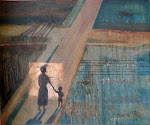Well, since I seem to be on a roll with the photos of buildings, I thought I'd share a couple more from my trip from port Elizabeth to East London last week. But first I need to set some background.
When you travel between the two cities, you can be forgiven for thinking you have entered some sort of time warp.... half an hour's travel takes you from 21st century modern into semi-primitive rural. I often allude to the 1st world/3rd world mixture we have here, and the incredible diversity of lifestyle in this country, and it is nowhere more evident than in the Eastern Cape.
In the Apartheid era, one of the more insidious strategies to separate the races was the creation of 'independant homelands'. The purpose was to fool the detractors of Apartheid into believing that Black people did have the vote (in their own homeland) and were allowed to own land. What was not highlighted was that the homelands were not economically viable.
These were generally large, remote impoverished rural areas, inhabited largely by tribes people who still live very much as they have for centuries. Because there was little or no industry, many of the men ended up going to the cities to find work, ending up on the mines, in hostels, and sending what money they could back home to their wives and children, who mostly scratched a living from the poor un-irrigated soils.

 and as Western culture has infiltrated tribal life, there is an interesting style if house, which is still in the rondavel form of the traditional house, but with corrogated iron roofing sheets.
and as Western culture has infiltrated tribal life, there is an interesting style if house, which is still in the rondavel form of the traditional house, but with corrogated iron roofing sheets.

So there you have it, in 3 days, you have seen a tiny cross section of South African architecture and the differing lifestyles it reflects, this really is a fascinating place to live.
 On an entirely different note, remember two days ago I was waxing lyrical about the EXPERIENCE of showering in the forest cottage. Well today I discovered that I can have an awesome showering experience literally in my own backyard! We have a little narrow private courtyard leading off from our bedroom, and last year when we were having some plumbing work done, I had a shower fitted out there. It is delightful showering outside in the fresh air on a warm day, standing on paving stones with rounded river pebbles around them, surrounded by plants and flowers.
On an entirely different note, remember two days ago I was waxing lyrical about the EXPERIENCE of showering in the forest cottage. Well today I discovered that I can have an awesome showering experience literally in my own backyard! We have a little narrow private courtyard leading off from our bedroom, and last year when we were having some plumbing work done, I had a shower fitted out there. It is delightful showering outside in the fresh air on a warm day, standing on paving stones with rounded river pebbles around them, surrounded by plants and flowers. 








3 comments:
That must be such a jolt to travel from one extreme to another in just a few hours. I do so enjoy your travel posts and the photos because it helps me understand more about other people and places.
That outdoor shower looks refreshing and with the scent of jasmine....how wonderful!!
Love the sign "stop and eat or we'll both starve."
~Oswegan
That's a funny sign (stop and eat).
Post a Comment